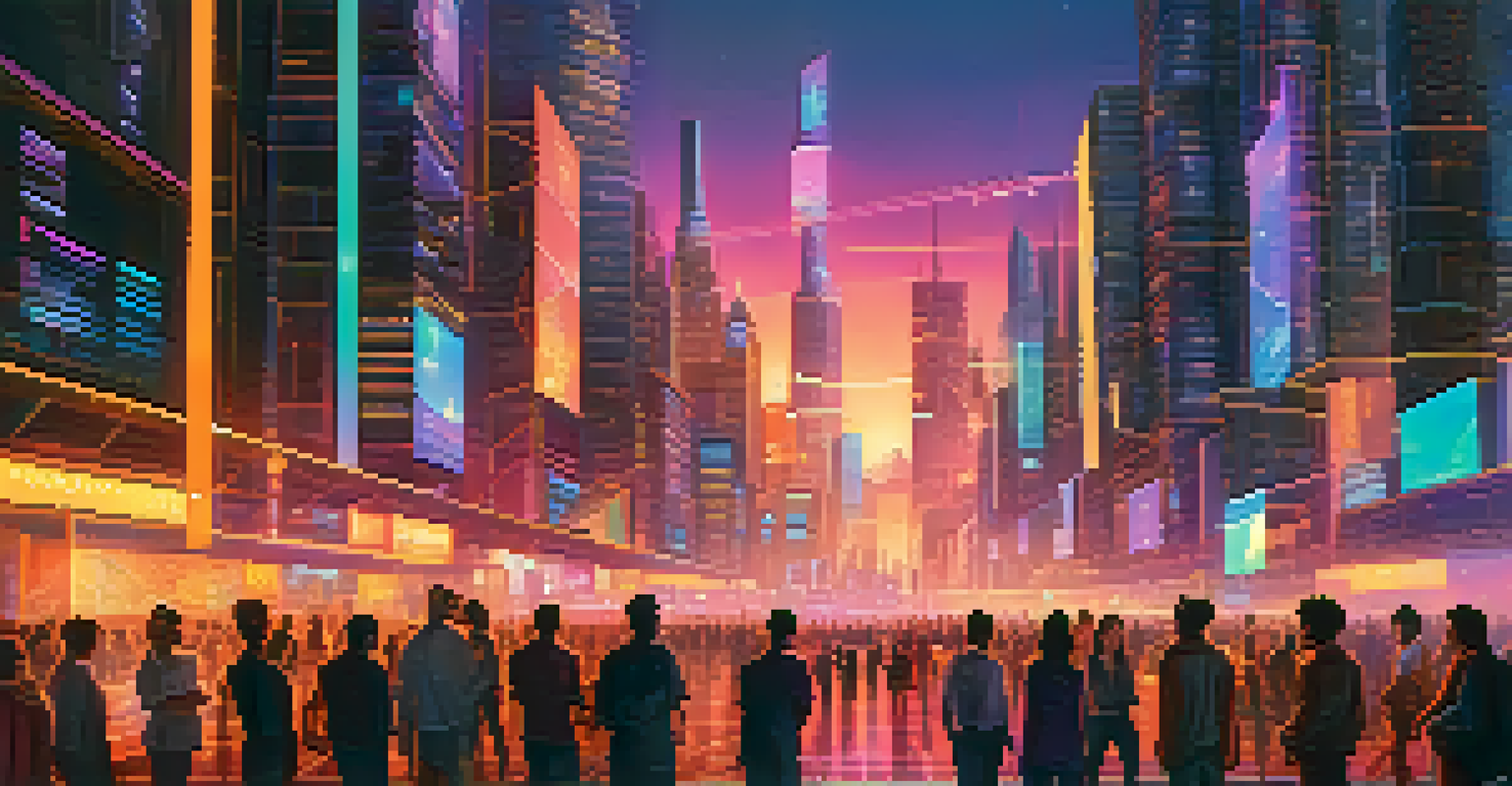The Pros and Cons of Digital Rights Management in Media

Understanding Digital Rights Management (DRM) in Media
Digital Rights Management, or DRM, refers to technologies used to control how digital content is used and distributed. Think of it as a virtual lock on your favorite movie or music that ensures only those who have purchased it can enjoy it. While it aims to protect the rights of creators and distributors, it also impacts how consumers access and experience this content.
Digital Rights Management is a way to ensure that the creators of digital content are compensated for their work, while also balancing consumer accessibility.
In essence, DRM encompasses a range of strategies, from encryption to licensing agreements, that help prevent unauthorized copying and sharing. This means that when you buy a song on a music platform, DRM ensures you can listen to it but might restrict how you can share or transfer it. Understanding these mechanics is crucial for anyone navigating the modern media landscape.
As we delve deeper into the pros and cons of DRM, it’s important to recognize its dual nature—it serves both as a safeguard for creators and a potential hurdle for consumers. This balance between protection and accessibility is at the heart of the ongoing debate surrounding DRM in media.
The Benefits of DRM for Creators and Distributors
One of the primary advantages of DRM is that it helps protect the intellectual property of creators. By preventing unauthorized copying, DRM ensures that artists, filmmakers, and authors can receive fair compensation for their work. Imagine an artist pouring their heart into a song, only to have it shared for free without their permission—DRM aims to prevent such scenarios.

Additionally, DRM can enhance the distribution process by allowing creators to set terms on how their work is shared and consumed. For instance, a publisher could limit access to a new book to only those who purchase it, thereby maintaining control over its distribution and market value. This fosters a more sustainable ecosystem for creators.
DRM Protects Creators' Rights
Digital Rights Management (DRM) helps safeguard the intellectual property of artists and creators by preventing unauthorized copying and ensuring fair compensation.
Furthermore, by implementing DRM, distributors can gain insights into consumption patterns, helping them make informed decisions about future releases. This data allows for targeted marketing strategies, ensuring that creators can connect with their audience more effectively. In this way, DRM can be a valuable tool for the creative industry.
The Drawbacks of DRM for Consumers
While DRM offers protection for creators, it often comes with significant drawbacks for consumers. One major issue is that DRM can limit a buyer's ability to use the content they have purchased. For example, if you buy a movie, DRM might restrict you to viewing it on a specific platform or device, making it less convenient to enjoy your content across different devices.
The future of digital content will depend on finding a balance between protecting creators' rights and allowing consumers the freedom to enjoy their purchases.
Moreover, DRM can lead to a frustrating experience if the technology fails. Imagine trying to access a movie you bought, only to find that you can’t because the DRM system is down or your device is outdated. This can leave consumers feeling powerless, as they have paid for something they cannot access when they want to.
Additionally, some consumers argue that DRM can create a culture of mistrust between creators and their audience. When people feel monitored or restricted, it can dampen their enthusiasm for purchasing digital content. This tension poses challenges for maintaining a healthy relationship between creators and their fans, ultimately affecting the media landscape.
The Impact of DRM on Content Sharing and Community
DRM can significantly impact how content is shared and consumed within communities. For many, sharing music, movies, or books with friends is a cherished tradition, fostering connections and discussions. However, with strict DRM policies in place, this sharing becomes more complicated, often limited to sharing links or using specific platforms.
This limitation can stifle the organic growth of fan communities that thrive on sharing and discussing media. When barriers are placed on how content can be shared, it can hinder the natural conversations that arise from enjoying media together. The joy of discovering a new artist through a friend's recommendation is often lost when sharing is restricted.
DRM Limits Consumer Freedom
While DRM provides protection for creators, it often restricts consumers' ability to fully enjoy and share the content they have purchased.
Moreover, the inability to share content easily can lead to a more isolated experience for consumers. As people are pushed towards individual consumption rather than community engagement, the communal aspect of enjoying media diminishes. This shift can have broader implications for how culture evolves and how communities form around shared interests.
The Technological Challenges of DRM
Implementing DRM technology presents numerous challenges, even for the companies that create it. One significant hurdle is ensuring that the methods used are both effective against piracy and user-friendly. Striking this balance can be a delicate dance, as overly complex systems may frustrate legitimate buyers.
Additionally, as technology evolves, so do the methods used by pirates to bypass DRM protections. This cat-and-mouse game means that companies must constantly update their systems, which can be resource-intensive. It’s akin to trying to build a fortress while the enemy learns to dig tunnels—it’s an ongoing challenge.
Furthermore, some DRM systems can inadvertently create vulnerabilities that hackers exploit, leading to leaks and unauthorized sharing. This irony highlights the complexity of managing digital rights—a system designed to protect often ends up creating new risks. Thus, the technological landscape of DRM is fraught with both opportunity and challenge.
Future Trends: The Evolution of DRM in Media
As the media landscape continues to evolve, so too will the approach to Digital Rights Management. With advancements in technology, new methods are emerging that prioritize user experience while still protecting creators’ rights. This shift reflects a growing recognition that consumers want more freedom over the media they purchase.
One promising trend is the rise of blockchain technology, which offers a decentralized way to manage rights and track usage. By utilizing this technology, creators could potentially regain more control over their work without imposing restrictive measures on consumers. This could lead to a more equitable system that benefits both parties.
Future Trends Favor User Experience
Emerging technologies, like blockchain, and a shift towards subscription models indicate a potential evolution in DRM that balances creator protection with enhanced consumer access.
Additionally, as consumer attitudes shift towards favoring access over ownership, we may see a move towards subscription-based models that reduce the need for DRM. These models often allow for easier access to a vast library of content, fostering a sense of community and shared experience. The future of DRM will likely be defined by its ability to adapt to these changing consumer preferences.
Conclusion: The Balancing Act of DRM in Media
In conclusion, Digital Rights Management serves as a double-edged sword in the media industry. On one side, it offers crucial protection for creators, ensuring they are compensated for their hard work. On the other side, it poses significant challenges for consumers, limiting how they can enjoy the content they purchase.
As we navigate the complexities of digital media, finding a balance between protecting rights and enhancing user experience is vital. The evolution of DRM will require ongoing discussions between creators, distributors, and consumers to ensure that all voices are heard. This collaborative approach could lead to solutions that respect the needs of both sides.

Ultimately, the future of DRM in media will hinge on its ability to adapt and evolve alongside technological advancements and changing consumer preferences. By fostering an environment where creativity can flourish while still providing consumers with access, we can create a healthier media ecosystem for everyone involved.